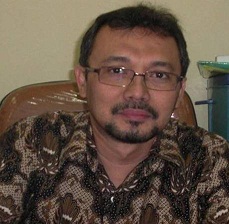Estimation of Phosphorus Storage in Seagrass in the Coastal Waters of Eastern and Northen Bintan Island
Downloads
The eastern and northern coastal waters of Bintan Island are seagrass conservation areas with high biodiversity and coverage. Seagrass is known to play an essential role in the carbon cycle and has the potential to store phosphorus, but limited information is available regarding its phosphorus reserves. This study aims to estimate phosphorus (P) storage in seagrass and analyze the relationship between seagrass ecological parameters and phosphorus content. A field survey and hierarchical sampling technique were conducted at six locations, with samples of seagrass, substrate, and water analyzed in laboratory. Results showed the highest seagrass density in Pengudang (816 shoots/m²) and the lowest in Berakit 2 (107 shoots/m²); the highest coverage in Teluk Bakau 1 (83.5%) and the lowest in Teluk Bakau 2 (43.1%); and the highest biomass in Pengudang (138.55 gr/m²) and the lowest in Berakit 2 (19.39 gr/m²). The highest phosphorus storage was recorded in Berakit 2 (0.321%) and the lowest in Teluk Bakau 2 (0.258%). A positive correlation was observed between coverage and phosphorus content, indicating that increased seagrass coverage potentially enhances phosphorus storage capacity. These findings offer new insights into the role of seagrass in the phosphorus cycle and its implications for sustainable coastal ecosystem management.
Aftari. (2021). Status mutu perairan dan kesehatan lamun di kawasan wisata Perairan Teluk Bakau Kecamatan Gunung Kijang Kabupaten Bintan. (Skripsi). Universitas Maritim Raja Ali Haji.
Aida, S. N., & Utomo, A. D. (2016). Kajian kualitas perairan untuk perikanan di Rawa Pening Jawa Tengah. BAWAL Widya Riset Perikanan Tangkap, 8(3):173-182.
Amara, F. D. (2023). Estimasi stok karbon dan kaitannya dengan kerapatan padang lamun di Pulau Bonetambung Kota Makassar. (Skripsi). Universitas Hasanuddin.
Andika, Y., Kawaroe, M., Effendi, H., & Zamani, N. P. (2020). Pengaruh kondisi pH terhadap respons fisiologis daun lamun jenis Cymodocea rotundata. Jurnal Ilmu dan Teknologi Kelautan Tropis, 12(2):485-493.
Andika, Y., Kawaroe, M., Effendi, H., Zamani, N. P., Adhar, S., Nurul'Akla, C. M., & Ilhami, B. T. K. (2023). Pengaruh perbedaan pH perairan terhadap laju pertumbuhan lamun jenis Cymodocea rotundata. Jurnal Ilmu dan Teknologi Kelautan Tropis, 15(1):99-111.
Andriani, A., Damar, A., Rahardjo, M. F., Simanjuntak, C. P., Asriansyah, A., & Aditriawan, R. M. (2017). Kelimpahan fitoplankton dan perannya sebagai sumber makanan ikan di Teluk Pabean, Jawa Barat. Jurnal Sumberdaya Akuatik Indopasifik, 1(2):133-144.
Asyiawati, Y., & Akliyah, L. S. (2014). Identifikasi dampak perubahan fungsi ekosistem pesisir terhadap lingkungan di wilayah pesisir Kecamatan Muaragembong. Jurnal Perencanaan Wilayah dan Kota, 14(1):1-13.
Azizah, E. (2017). Kerapatan dan biomassa lamun Enhalus acoroides di perairan Desa Jago-Jago Tapanuli Tengah Provinsi Sumatera Utara. Fakultas Perikanan dan Kelautan, Universitas Riau.
Baird, R. B., Eaton, A. D., & Rice, E. W. (Eds.). (2017). Standard methods for the examination of water and wastewater. 23th Edition. American Public Health Association, American Water Works Association, Water Environment Federation.
Bennett, E.M., Carpenter, S.R. & Caraco, N. F. (2001). Human impact on erodable phosphorus and eutrophication: A global perspective. BioScience, 51(3):227-234
Bongga, M., Sondak, C. F., Kumampung, D. R., Roeroe, K. A., Tilaar, S. O., & Sangari, J. (2021). Kajian kondisi kesehatan padang lamun di perairan Mokupa Kecamatan Tombariri Kabupaten Minahasa. Jurnal Pesisir dan Laut Tropis, 9(3):44-54.
Damayanti, A. S. (2011). Pola konektivitas sistem sosial-ekologi dalam pengelolaan ekosistem lamun (Kajian efektivitas pengelolaan kawasan konservasi padang lamun di Desa Malang Rapat dan Desa Teluk Bakau, Kabupaten Bintan). (Thesis). Universitas Indonesia. Jakarta.
Duarte, C. M. (1990). Seagrass nutrient content. Marine Ecology Progress Series, 67:201-207
Felisberto, M. H. F., Wahanik, A. L., Ruffi, C. R., Clerici, M. T. P. S., Chang, Y. K., Steel, C. J. (2015). Use of chia (Salvia hispanica L.) mucilage gel to reduce fat in pound cakes. Lebensmittel Wissenchaft and Technologie-Food Science and Technology, 63(2): 1049-1055.
Gosari, J. A., & Haris, A. (2012). Studi kerapatan dan penutupan jenis lamun di Kepulauan Spermonde. Torani: Jurnal Ilmu Kelautan dan Perikanan, 22(3):256-162.
Habibah, S. N., Febriamansyah, R., & Mahdi. (2023). Efektifitas pengelolaan kawasan konservasi lamun di Kawasan Konservasi Perairan Wilayah Timur Pulau Bintan. Jurnal Akuatik Lestari, 6(2):168-178.
Handayani, D. R., Armid, A., & Emiyarti, E. (2016). Hubungan kandungan nutrien dalam substrat terhadap kepadatan lamun di Perairan Desa Lalowaru Kecamatan Moramo Utara. (Disertasi). Universitas Haluoleo.
Hapsari, F. N., Maslukah, L., Dharmawan, I. W. E., & Wulandari, S. Y. (2022). Simpanan karbon organik dalam sedimen mangrove terhadap pasang surut di Pulau Bintan. Buletin Oseanografi Marina, 11(1):86-98.
Hardiyanti, S., Umar, M. R., & Priosambodo, D. (2011). Analisis vegetasi lamun di perairan Pantai Mara Bombang Kabupaten Pinrang. E-Journal FMIPA. Universitas Hasanuddin.
Hasanuddin, R. (2013). Hubungan antara kerapatan dan morfometrik lamun Enhalus acoroides dengan substrat dan nutrien di Pulau Sarappo Lompo Kabupaten Pangkep. (Skripsi). Universitas Hasanuddin.
Indriyani, R., Nurgayah, W., & Ira. (2022). Kandungan nitrat dan fosfat sedimen pada kawasan padang lamun di Perairan Kolese Kota Baubau. Sapa Laut, 7(4):193-199.
Irma, P. H. (2024). Estimasi simpanan karbon organik pada lamun di perairan pesisir Timur Pulau Bintan. (Skripsi). Universitas Maritim Raja Ali Haji.
Isnaini, I., & Aryawati, R. (2023). Kerapatan lamun dan hubungan dengan parameter lingkungan di perairan pesisir Teluk Lampung. Buletin Oseanografi Marina, 12(3):331-339.
Jemi. (2022). Struktur populasi ikan baronang (Siganus sp) pada ekosistem lamun di pesisir Pulau Bintan. (Skripsi). Universitas Maritim Raja Ali Haji.
Kawaroe, M., Nugraha, A. H., Juraij, J., & Tasabaramo, I. A. (2016). Seagrass biodiversity at three marine ecoregions of Indonesia: Sunda shelf, Sulawesi Sea, and Banda Sea. Biodiversitas Journal of Biological Diversity, 17(2):585-591.
Kementrian Lingkungan Hidup. (2004). Keputusan Menteri Lingkungan Hidup Nomor 200 tentang Kriteria baku kerusakan dan pedoman penentuan status padang lamun. Jakarta.
Khairunnisa, K., Setyobudiandi, I., & Boer, M. (2018). Estimasi cadangan karbon pada lamun di pesisir timur Kabupaten Bintan. Jurnal Ilmu dan Teknologi Kelautan Tropis, 10(3):639-650.
Koch, E. W, Booth, D. M., & Palinkas, C. (2012, November). Seagrasses and the ecosystem service of shoreline protection (or is it sediment stabilization?). In J. C. Creed, S. S. OigmanPszczol (Eds.), Proceeding 10th International Seagrass Biology Workshop (ISBW10), 25–30 Nov. 2012. Armac¸ ão dos Búzios, Brazil. Instituto Biodiversidade Marinha, Rio de Janeiro, Brazil.
Lewerissa, Y. A., Sangaji, M., & Latumahina, M. B. (2018). Pengelolaan mangrove berdasarkan tipe substrat di perairan Negeri Ihamahu Pulau Saparua. Triton: Jurnal Manajemen Sumberdaya Perairan, 14(1):1-9.
Martínez-crego B, Vergés A, Alcoverro T, Romero J. (2008). Selection of Multiple Seagrass Indicators for Environmental Biomonitoring. Marine Ecology Progress Series, 361:93-109.
Mashoreng, S., Selamat, M. B., Amri, K., & La Nafie, Y. A. (2018). Hubungan antara persen penutupan dan simpanan karbon lamun. Akuatika Indonesia, 3(1):74-83.
Meirinawati, H., & Muchtar, M. (2017). Fluktuasi nitrat, fosfat dan silikat di Perairan pulau Bintan. Jurnal Segara, 13(3):141-148.
Nabilla, S., Hartati, R., & Nuraini, R. A. T. (2019). Hubungan nutrien pada sedimen dan penutupan lamun di perairan Jepara. Jurnal Kelautan Tropis, 22(1):42-48.
Nugraha, A. H., Srimariana, E. S., Jaya, I., & Kawaroe, M. (2019) Struktur ekosistem lamun di Desa Teluk Bakau, pesisir Bintan Timur-Indonesia. Depik, 8(2):87-96.
Nurmasari, R., Putri, A. H. A., Rosmaida, S., Nurkhalifah, U., & Ramadhan, F. (2023). Identifikasi tutupan dan kondisi perairan pada ekosistem lamun di Pulau Tidung Kecil. Jurnal Teknologi Perikanan dan Kelautan, 14(1):25-32.
Nybakken, J. (1992). Biologi laut pendekatan ekologis. Jakarta: Penerbit Gramedia.
PP (Peraturan Pemerintah). (2021). PP No. 22 Tahun 2021 tentang Penyelenggaraan perlindungan dan pengelolaan lingkungan hidup, Lampiran VIII mengenai baku mutu air laut peruntukan biota laut (lamun).
Rahman, A, A., Nur, I. A., Ramli, M. (2016) Studi laju pertumbuhan lamun Enhalus acoroides di Perairan Pantai Desa Tanjung Tiram Kabupaten Konawe Selatan. Sapa Laut, 1(1):10-16.
Rahmawati, S., Irawan, A., Supriyadi, H. I., & Azkab, M. H. (2014). Panduan monitoring padang lamun. Jakarta: LIPI.
Ramadhan, S., Tiwow, V. M., & Said, I. (2016). Analisis kadar unsur nitrogen (N) dan posforus (P) dalam lamun (Enhalus acoroides) di Wilayah Perairan Pesisir Kabonga Besar Kecamatan Banawa Kabupaten Donggala. Jurnal Akademika Kimia, 5(1):37-43.
Rizal, A. C., Ihsan, Y. N., Afrianto, E., & Juliadi, L. P. (2017). Pendekatan status nutrien pada sedimen untuk mengukur struktur komunitas makrozoobentos di wilayah muara sungai dan pesisir Pantai Rancabuaya, Kabupaten Garut. Jurnal Perikanan dan Kelautan, 8(2):7-16.
Silburn, B., Kröger, S., Parker, E. R., Sivyer, D. B., Hicks, N., Powell, C. F., Johnson, M., & Greenwood, N. (2017). Benthic pH gradients across a range of shelf sea sediment types linked to sediment characteristics and seasonal variability. Biogeochemistry, 135(1–2):69-88.
Silvi, M. V., Redjeki, S., & Riniatsih, I. (2022). Kandungan nutrien di sedimen pada ekosistem padang lamun di Teluk Awur dan Pulau Panjang, Jepara. Journal of Marine Research, 11(3):420-428.
Sjafrie, N. D. M. (2018). Identifikasi sistem sosial-ekologis (SES) ekosistem lamun di Kabupaten Bintan. Oseanologi dan Limnologi di Indonesia, 3(2):123-135
Subiakto, A. Y., Santosa, G. W., Suryono, S., & Riniatsih, I. (2019). Hubungan kandungan nitrat dan fosfat dalam substrat terhadap kerapatan lamun di Perairan Pantai Prawean, Jepara. Journal of Marine Research, 8(1):55-61.
Sugiyono. (2018). Metode penelitian kualitatif. Bandung: Alfabeta.
Sugiyono (2019). Metode penelitian pendekatan kuantitatif, kualitatif dan R & D. Bandung: Alfabeta.
Terrados, J., & Medina-Pons, F. J. (2011). Inter-annual variation of shoot density and biomass, nitrogen and phosphorus content of the leaves, and epiphyte load of the seagrass Posidonia oceanica (L.) Delile off Mallorca, Western Mediterranean. Scientia Marina, 75(1):61-70.
Thangaradjou, T., & Kannan, L. (2007). Nutrient characteristics and sediment texture of the seagrass beds of the Gulf of Mannar. Journal of Environmental Biology, 28(1):29-33.
Trygonis, V., & Sini, M. (2012). photoQuad: A dedicated seabed image processing software, and a comparative error analysis of four photoquadrat methods. Journal of Experimental Marine Biology and Ecology. 424–425:99-108.
Widiyanti, V. R., Sedjati, S., & Nuraini, R. A. T. (2018). Korelasi kandungan nitrat dan fosfat dalam air dan sedimen dengan kerapatan lamun yang berbeda di Perairan Teluk Awur, Jepara. Journal of Marine Research, 7(3):193-200.
Wulandari, U., Wirawan, I., & Agustini, M. (2018). Oceanographic characteristics in Probolinggo as the potential fishing ground of Sardinella fimbriata. Samakia: Jurnal Ilmu Perikanan, 9(2):37-44.
Yamamuro, M., Kayanne, H. & Yamho, H. (2003). 15 N of seagrass leaves for monitoring antrogenic nutrient increase in coral reef ecosystems. Marine Pollution Bulletin, 46:452-458.
Copyright (c) 2025 Journal of Marine and Coastal Science

This work is licensed under a Creative Commons Attribution-NonCommercial-ShareAlike 4.0 International License.













